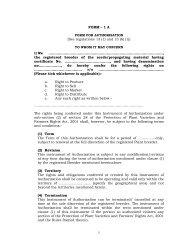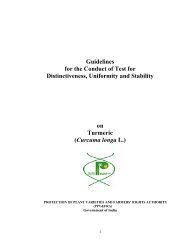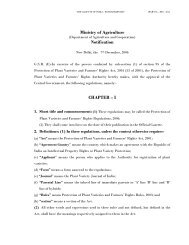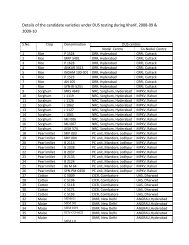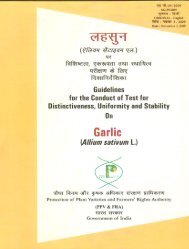Chrysanthemum - Protection of Plant Varieties & Farmers
Chrysanthemum - Protection of Plant Varieties & Farmers
Chrysanthemum - Protection of Plant Varieties & Farmers
Create successful ePaper yourself
Turn your PDF publications into a flip-book with our unique Google optimized e-Paper software.
Xkqynkmnh¼dzkblsaFksee½dhf<strong>of</strong>'k"Vrk] ,d:irk rFkk LFkkf;Ro gsrqijh{k.k djus ds fy,fn'kkfunsZf'kdkGuidelinesfor the Conduct <strong>of</strong> Test forDistinctiveness, Uniformity and StabilityOn<strong>Chrysanthemum</strong>(<strong>Chrysanthemum</strong>)ikS/kk fdLe vkSj d`"kd vf/kdkj laj{k.k izkf/kdj.k<strong>Protection</strong> <strong>of</strong> <strong>Plant</strong> <strong>Varieties</strong> and <strong>Farmers</strong>’ Rights Authority(PPV & FRA)Hkkjr ljdkjGovernment <strong>of</strong> India
I.II.5
III.6
IV.VII7
IV.8
iiiVI.VII(*)(+) VIII9
QL, QNPQQLQNPQ(a)- (h)VIIIVII.1.(*)QN(a)(20-40)(60)2.(*)(+)10
QL(a)3.(*)(+)PQ(a)4.PQ(a)(b)5.(*)6.7.8.QN(a)(b)11
9.(+)QN(a)(c)10.(+)QN(a)(c)11.12.(*)QN(a)(c)(7)13.(*)QN(a)(c)(5)14.(+)(*)15.12
16.17.(*)(+)QN(a)(c)18.PQ(a)(c)19.(+)(*)20.(+)21.22.(*)(+)13
23.24.25.(+)(*)PQ(a)(c)26.QN(a)(c)27.(*)(+)QN(a)(c)28.29.(*)(+)PQ(d)14
30.(+)QN(d)31.(+)32.(*)(+)PQ33.(*)QN34.(+)QN(d)35.36.(+)QN15
37.PQ(a)(e)38.(*)QN(e)39.40.(+)(*)PQ(e)(f)41.(*)(+)42.16
43.(+)(*)PQ(e)44.(*)QN(e)(f)45.(+)PQ(e)(f)46.(*)47.(*)48.(*)(+)PQ(e)(f)17
49.(*)(+)50.(*)QN(e)(f)51.(*)QN(e)(f)52.(*)QN(e)(f)53.(*)(+)PQ(e)(f)54.(+)18
55.(i)(*)PQ(e)(f)55.(ii)55.(iii)56.i57.ii19
58.(+)QN(e)(f)59.(*)PQ(e)(f)(g)60.(*)PQ(e)(f)(g)61.(*)(+)PQ(e)(f)(g)20
62.(*)(+)PQ(e)(f)(g)63.64.65.66.67.(*)68.(+)21
69.(i)(+)QN(e)69.(ii)(+)PQ(e)70.PQ(e)(h)71.(*)PQ(e)72.(+)(*)PQ22
73.(*)(+)PQ(e)74.(*)PQ(e)75.(*)PQ(+)76.(+)QN77.23
78.VIII.a-h24
L30
III37
IX.39
<strong>Chrysanthemum</strong> (<strong>Chrysanthemum</strong> )I. SubjectThese Test Guidelines shall apply to all varieties, parental lines <strong>of</strong> <strong>Chrysanthemum</strong> ×morifolium Ramat. (<strong>Chrysanthemum</strong> × grandiflorum Ramat.), <strong>Chrysanthemum</strong> pacificumNakai (Ajania pacifica Bremer and Humphries) and hybrids between them.II. <strong>Plant</strong> Material required1. The <strong>Protection</strong> <strong>of</strong> <strong>Plant</strong> <strong>Varieties</strong> & <strong>Farmers</strong>‟ Rights Authority (PPV&FRA) shall decideswhen, where and in what quantity and quality the plant material are required for testing <strong>of</strong> avariety denomination for registration under the <strong>Protection</strong> <strong>of</strong> <strong>Plant</strong> <strong>Varieties</strong> and <strong>Farmers</strong>‟Rights (PPV&FR) Act, 2001. Applicants submitting such material from a country other thanIndia shall make sure that all customs and quarantine requirements stipulated under relevantnational legislations and regulations are complied with. For all varieties, 100 two-nodeterminal rooted cuttings (50 for each center) taken from mother plants (at least 8-12 weeks <strong>of</strong>age) shall be required for DUS testing. If however any material for DUS test has a specificrequirement for the expression <strong>of</strong> characters, the same shall be specified by the applicant.2. The plant material supplied shall be healthy, not lacking in vigor or affected by any importantpest or disease.3. The plant material shall not have undergone any chemical or bio-physical treatment, unlessthe competent authority or request for such treatment. If it has been treated, full details <strong>of</strong> thetreatment must be given.4. The applicant shall also submit along with the plant material, a certified data ongermination/sprouting test made not more than one month prior to date <strong>of</strong> submission. It shallalso possess the highest genetic purity, uniformity, sanitary and phyto-sanitary standards.41
III. Conduct <strong>of</strong> Tests:1. The minimum duration <strong>of</strong> the test shall normally be one independent growing season withreference to the ecosystem <strong>of</strong> the variety submitted for DUS test. However, in case thematerial entered does not meet the DUS criteria for any one or more than one character, thenthe test shall be extended for the next year.2. Tests shall normally be conducted at one place. If any essential characteristics <strong>of</strong> the varietyare not expressed for visual observations at this place, the variety shall be considered forfurther examination at another appropriate test site or under special test protocol on expressedrequest <strong>of</strong> the applicant.3. The field tests shall be carried out under conditions favouring normal growth and expression<strong>of</strong> all test characteristics. The size <strong>of</strong> the plots shall be such that plants or parts <strong>of</strong> plants couldbe removed for measurement and observation without prejudicing the other observations onthe standing plants until the end <strong>of</strong> the growing period.4. In particular, growth regulators should not be used.5. <strong>Varieties</strong> should be disbudded, if bred for such use, but where necessary, in the case <strong>of</strong> dualpurpose varieties, distinctiveness should also be checked on non-disbudded plants.IV. Methods and observations1. The characteristics described in the Table <strong>of</strong> characteristics shall be used for the testing <strong>of</strong>varieties for their DUS (section VII).2. Unless otherwise indicated, the optimum stage <strong>of</strong> development for the assessment <strong>of</strong> thecharacteristics is the time <strong>of</strong> full flowering.3. All observations on vegetative organs shall be recorded unless otherwise indicated on themiddle third <strong>of</strong> the stem. Colours <strong>of</strong> vegetative organs shall be observed on plants exposed tomaximum light.4. All observations on floral parts shall be made on terminal flower heads. The colour <strong>of</strong> the rayflorets shall, unless otherwise indicated be recorded at stage 8 on the scale <strong>of</strong> flower headdevelopment (Cockshull & Hughes, 1967 & 1972).5. Unless otherwise indicated, all observations on single plants shall be made on 20 plants orparts taken from each <strong>of</strong> 20 plants and any other observations made on all plants in the test.42
6. Each test shall include a total <strong>of</strong> at least 50 plants in two replications. For assessment <strong>of</strong>Distinctiveness and Stability, all observations shall be made on 40 plants out <strong>of</strong> 50 plants. Out<strong>of</strong> the 40 plants, 20 plants shall be disbudded / pinched and the other 20 plants withoutdisbudding/pinching.7. For the assessment <strong>of</strong> Uniformity <strong>of</strong> vegetatively propagated varieties, a population standard<strong>of</strong> 1% and an acceptance probability <strong>of</strong> at least 95 % shall be applied. In the case <strong>of</strong> a samplesize <strong>of</strong> 20 plants, 1 <strong>of</strong>f-type is allowed. In practice, it is not usual to perform tests <strong>of</strong> Stabilitythat produce results as certain as those <strong>of</strong> the testing <strong>of</strong> Distinctiveness and uniformity.However, experience has demonstrated that for many types <strong>of</strong> variety, when a variety hasbeen shown to be uniform, it can also be considered to be stable. Where appropriate or incases <strong>of</strong> doubt, stability may be tested either by growing a further generation or by testing anew plant stock to ensure that it exhibits the same characteristics as those shown by theprevious material supplied.8. For the assessment <strong>of</strong> colour characteristics, the latest Royal Horticultural Society (RHS)colour chart shall be used. Because daylight varies, colour determinations made against colourchart shall be made either in a suitable cabinet providing artificial daylight or in the middle <strong>of</strong>the day in a room without direct sunlight. The special distribution <strong>of</strong> illuminant for artificialdaylight should conform with the CIE Standard <strong>of</strong> Preferred daylight D 6500 and should fallwithin the tolerance set out in the British Standard 950, Part 1.The DUS test centre mustacquire them to ensure uniform observation. These determinations shall be made with theplant part placed against a white background.9. Additional tests protocols for special purpose shall be established by the PPV&FR Authority.10. Standard cultural practices to be adopted and specified as may be relevant to the location <strong>of</strong>the DUS test centres for open and greenhouse conditions. If however, any material entered forthe DUS test has any specific requirement for expression <strong>of</strong> characters, the same will bespecified by the applicant. The DUS test centres shall finalize the standard cultural practiceswith the approval <strong>of</strong> the Authority.V. Grouping <strong>of</strong> <strong>Varieties</strong>1. The candidate varieties for DUS testing shall be divided into groups to facilitate theassessment <strong>of</strong> Distinctiveness. Characteristics which are known from experience not to vary43
or to vary only slightly with in a variety and which in their various states are fairly evenlydistributed across all varieties in the collection are suitable for grouping purpose.2. The following characteristics shall be used for grouping chrysanthemum varieties:1. <strong>Plant</strong> type (Characteristic 2)2. Variety class (Characteristic 28)3. Flower head: Type (Characteristic 32)4. Ray floret: Longitudinal axis (Characteristic 40)<strong>of</strong> majority <strong>of</strong> ray florets5. Ray floret: Colour <strong>of</strong> inner (Characteristic 55 iii)side <strong>of</strong> majority <strong>of</strong> ray florets6. Disc: Type (Characteristic 68)7. Flower type (Characteristic 77)8. Economic use (Characteristic 78)VI. Characteristics and symbols1. To assess Distinctiveness, Uniformity and Stability, the characteristics and their states asgiven in the Table <strong>of</strong> characteristics (section VII) shall be used.2. Notes (1-9)) shall be used to describe the state <strong>of</strong> each character for the purpose <strong>of</strong> digitaldata processing.3. Legend(*) Characteristics that shall be observed during every growing season on all varieties andshall always be included in the description <strong>of</strong> the variety, except when the state <strong>of</strong>expression <strong>of</strong> any <strong>of</strong> these characters is rendered impossible by a preceding phenologicalcharacteristic or by the environment conditions <strong>of</strong> the testing region. Under suchexceptional situation, adequate explanation shall be provided.(+) See explanations on the Table <strong>of</strong> characteristics.4. Characteristics denoted with symbols QL, QN and PQ in first column <strong>of</strong> the Table <strong>of</strong>characteristics shall be indicated as:QL: Qualitative characteristicQN: Quantitative characteristicPQ: Pseudo-qualitative characteristic5. (a)- (h): see section VIII for explanation6. Type <strong>of</strong> assessment <strong>of</strong> characteristics indicated in column no. sixth <strong>of</strong> the Table <strong>of</strong>characteristics is as follows:44
MG: Measurement by a single observation <strong>of</strong> a group <strong>of</strong> plants or parts <strong>of</strong> plantsMS:VG:VS:Measurement <strong>of</strong> a number <strong>of</strong> individual plants or parts <strong>of</strong> plantsVisual assessment by a single observation <strong>of</strong> a group <strong>of</strong> plants or parts <strong>of</strong> plantsVisual assessment by observations <strong>of</strong> individual plants or parts <strong>of</strong> plantsVII. Table <strong>of</strong> characteristicsS. No. Characteristics States Notes1.(*)QN(a)<strong>Plant</strong>: Height(cm)Example varietiesVery short (60) 7 Geetanjali, Indira, ArkaGanga, Kajal, Gulmohar<strong>Plant</strong>: Type Non bushy 1 Poornima, Thai Chin Queen VGBushy 2 Jaya, Dolly Orange, PinkCloud, Shanti, Yellow Charm,Lilliput3.(*)(+)PQ(a)Only bushyvarieties- <strong>Plant</strong>:Growth habitUprightSemi - uprightSpreadingTrailing1357-Basanti, Gaity, Red GoldYellow Charm, Lilliput,Sadbhavana-VG45
4.PQ(a)(b)Stem: ColourGreenGreen tinged withpurple or brown12Poornima , Kundan, Thai ChenQueen , President Viger-VGBrown3-Purple4-5.(*)Stem:Anthocyanincolouration6. Stem:Brittleness7. Lateral shoot:Attachment tostemAbsentPresentBrittleNon brittleWeakMedium191935Jubilee, ShantiJayanti, Lal Pari, Arka Swarna,White ProlificAjay, Shanti, PunjabAnuradha, Indira, Pink Cloud,Geetanjali-----Nanako, Apsara, Arka GangaShanti, Lal Pari, MotherTherasa , Ratlam SelectionVSVSVSStrong7Ajay, Jayanti8.QN(a)(b)Stipule: SizeSmallMedium35Ajay, Shanti, Pink Cloud,Yellow Bangla, SadbhavanaLal Pari, Apsara, Arka Swarna,SharadmalaVS9.(+)QN(a)(c)10.(+)QN(a)(c)Petiole attitudePetiole: Lengthrelative to leaflengthLargeUpwardsHorizontalDownwardsShortMediumLong7135357Poornima, Vasantika, YellowGoldShyamal, Flirt, Kajal,Gulmohar, Kanchil--Basanti, GaityKargil, Ravi Kiran, NilimaKajal, Dolly Orange, PinkCloudVGVS46
11. Leaf: Texture Fleshy1Kasturba Gandhi, PoornimaVS12.(*)QN(a)(c)Leaf: Length <strong>of</strong>lamina(cm)LeatheryShort (7)Narrow (5)SerratedEntire735719Pink Cloud, Tokyo Soldier,Poornima, Ajay OrangeYellow Charm, LilliputBirbal Sahani, Kalvin Orange,Kalvin YellowShyamal, Flirt ,Kajal,GulmoharDolly Orange, Pink Cloud,Shanti-MSVS15. Leaf: Number<strong>of</strong> lobesFewMedium13Jubilee, Kajal, Yellow GoldThai Chin Queen, PresidentViger, Shardmala, Waters MayVSMany5Texas Gold, Dolly Orange16. Leaf: Depth <strong>of</strong>lobesShallow1Yellow Charm, Poornima,Birbal SahaniVSMedium3Nilima, Geetanjali, Lal Pari17.(*)(+)QN(a)(c)Leaf: Depth <strong>of</strong>lowest lateralsinusDeepShallowMediumDeep5357Ravi Kiran, Kargil, Jaya, DollyOrangePink Cloud, Poornima, BirbalSahaniKalvin Orange, Kalvin Yellow,MaghamiRavi Kiran, Texas Gold, Jaya,Dolly OrangeVS47
18.PQ(a)(c)Leaf : Margins<strong>of</strong> sinusbetween laterallobesDivergingParallel12Geetanjali, JubileeYellow Bangla, Yellow Gold,Maghi White, Maghi YellowVS19.(+)(*)Leaf:Magnitude <strong>of</strong>serrationConvergingShallowMedium335Birbal Sahani, Kalvin Orange,Kalvin Yellow, AjayRed Gold, GeetanjaliShanti, LiliputVS20.(+)Leaf : Number<strong>of</strong> serrationsDeepFewMedium735President Viger, Lal Pari,Aparajita-Kargil, Kajal, Thai ChinQueen, Waters MayVS21. Leaf: Colour(upper side)ManyRHS colour chart(indicate referencenumber)7Kalvin Orange, Kalvin Yellow,Ajay- VG22.(*)(+)Leaf: Colour(lower side)RHS colour chart(indicate referencenumber)- VG23. Leaf: Length <strong>of</strong>lower lobeShortMedium35Pitamber, VarthurPoornima, Arka Swarna,SharadmalaVS24. Leaf: Shape <strong>of</strong>base <strong>of</strong> sinusbetween laterallobesLongAcuteRound712Sonar Bungla, RatlamSelectionKasturba Gandhi, MaghamiPoornima, Sonar Bangla,Ratlam SelectionVS48
25.(+)(*)PQ(a)(c)Leaf: Shape <strong>of</strong>baseAcuteObtuseRounded123Ajay, Mother TheresaShanti, Jayanti, Shukla, PinkCloudApsara, Shyamal, MaghiWhite, Maghi YellowVSTruncate4Kasturba Gandhi, Poornima,IndiraCordate5-26.QN(a)(c)Leaf glossiness<strong>of</strong> upper sideAsymmetricAbsentWeakStrong6123Sonar Bangla-Jubilee, Kargil, Ravi KiranKalvin Orange, Kalvin YellowVG27.(*)(+)QN(a)(c)Leaf:Pubescence <strong>of</strong>lower sideWeakMediumStrong28. Variety class Standard29.(*)(+)PQ(d)30.(+)QN(d)Inflorescence:FormInflorescence:Width at widestpointSprayMiniCorymbiformPyramidalCylindricalNarrowMedium35712312335Jaya, Dolly Orange,SadbhavanaAprajita, White Andaman,White ProlificYellow Charm, LiliputKajal, Kanchil, Poornima,ThaiChin QueenBasanti, Gaity-Apsara, Geetanjali, ArkaSwarna , Sharad MalaVarthur-Yellow Charm, Liliput,Poornima, Birbal SahaniWhite Prolific, President VigerVGVGVSVSBroad7Nilima, Jubilee, Kargil49
31.(+)32.(*)(+)PQInflorescence:Number <strong>of</strong>flower headsshowing colour(when terminalflower head isat stage 8)Flower head:TypeLowMediumHighSingleSemi-double35712-Apsara, Ajay, ShyamalGeetanjali, White Prolific,RavikiranTexas Gold, Yellow Charm,Lilliput, SadbhavanaRatlam Selection, Lal Pari,AprajitaVGVG33.(*)QNFlower head:DiameterDoubleSmallMedium335Kasturba Gandhi, Poornima,ShyamalTexas Gold , Lal Pari ,Aprajita, ShantiPink Cloud, LiliputMS34.(+)QN(d)Total number <strong>of</strong>flower headsper stem35. Flower head:PedunclethicknessLargeFewMediumManyThinMedium735735Kanchil, PoornimaKajal, Waters MayKanchil, ShantiDolly Orange, Pink Cloud,Yellow CharmPink Cloud, Yellow Charm,LilliputRed Gold, Nilima, GeetanjaliVGVS36.(+)QN37.PQ(a)(e)Flower head:Length <strong>of</strong>peduncleFlower bud:Colour <strong>of</strong> outerside just beforefloweringThickShortMediumLongRHS colour chart(indicate referencenumber)7357Kajal, Gulmohar, KanchilShanti, Jayanti, Punjab VSAnuradhaApsara, Geetanjali, ArkaSwarnaPoornima, Ravi Kiran, ArkaGanga- VG50
38.(*)QN(e)Semi- doublevarieties onlyFlower head:Number <strong>of</strong> rows<strong>of</strong> ray floretFewMediumMany357Varthur, Yellow Charm,LilliputLal Pari, Geetanjali, PinkCloudJaya, Shanti, Maghi WhiteVS39. Flower head:Number <strong>of</strong> rows<strong>of</strong> involucralbracts40.(+)(*)PQ(e)(f)Ray floret:Longitudinalaxis <strong>of</strong> majority<strong>of</strong> ray floretsFive or lessMore than fiveReflexingStraightIncurving12123Apsara, GeetanjaliVarthur, KanchilApsara, Shukla , SharadmalaYellow BanglaGeetanjali, Indira, PunjabAnuradhaArka Swarna , Birbal SahaniKajal, KanchilMSVSTwisted4Waters May41.(*)(+)Ray floret:Longitudinalaxis <strong>of</strong> rayflorets <strong>of</strong> outerrowBrokenReflexingStraightIncurvingTwisted51234-Shukla , Sharadmala, Shanti,White ProlificGeetanjali, Indira, PunjabAnuradha, Basanti,GaityArka Swarna , Birbal Sahani,KanchilFlirt, Gulmohar, Waters MayVS42. Flower head:Number <strong>of</strong>types <strong>of</strong> rayfloretsBrokenOneTwoMore than two5123-Red Gold, Ravi KiranGaity, Nilima, Geetanjali,Jubilee-VS51
43.(+)(*)PQ(e)Flower head :Predominanttype <strong>of</strong> rayfloretsLigulateIncurvedSpatulate123Yellow Charm, SadvinYellow, Lilliput-Red Gold, Nilima, JubileeVSQuilled4Ravi Kiran44.(*)QN(e)(f)Ray floret:Length <strong>of</strong>corolla tubeFunnel shapedShortMediumLong5357-White Prolific, Ajay, WhiteAndamanPink Cloud, PoornimaShyamal, Ravikiran, KanchilVS45.(+)PQ(e)(f)46.(*)47.(*)48.(*)(+)PQ(e)(f)Ray floret :Upper surface<strong>Varieties</strong> withshort corollatube only: Rayfloret: Crosssection <strong>of</strong> rayfloret<strong>Varieties</strong> withshort corollatube only: Rayfloret: Keel<strong>Varieties</strong> withshort corollatube only: Rayfloret: KeelnumberSmoothRibbedKeeledConcaveFlatConvexAbsentPresentOneTwoThree12312319123--Red Gold, Geetanjali, Jubilee,KargilMaghami, Shukla, RatlamSelection,Thai Chin QueenWhite Prolific, Pink CloudShardmala, Waters May,Yellow Bangla, Sadbhavana,Yellow GoldArka SwarnaPink Cloud, Maghi White,Maghi Yellow, Kalvin Orange-Texas Gold, Lal Pari, Aprajita,FlirtKargil, Jaya, White Prolific,Thai Chin QueenVSVSVSMSMore than three4Sukla, Gulmohar, SadvinYellow, Poornima52
49.(*)(+)50.(*)QN(e)(f)<strong>Varieties</strong> withlong corollatube only: Rayfloret: Shape <strong>of</strong>endRay floret:Length <strong>of</strong> outerfloretsQuilledSpatulateIncurvedShortMedium12335Kasturba Gandhi, RavikiranJubilee, Shyamal, Kajal,KanchilPoornima, Sonar Bangla, ArkaSwarna , Birbal SahaniShanti, Punjab Anuradha ,Kundan, VasantikaGulmohar, Ratlam Selection,ShardmalaVSVS51.(*)QN(e)(f)52.(*)QN(e)(f)53.(*)(+)PQ(e)(f)Ray floret:Width <strong>of</strong> outerfloretsRay floret:Ratio(length/width)Ray floret:Shape <strong>of</strong> tipLongNarrowMediumBroadLowMediumHighPointedRoundedTruncatedDentate73573571234Kasturba Gandhi, Waters MayWhite Prolific, Shanti, ShuklaKasturba Gandhi, Poornima,Ajay, Yellow BanglaSonar Bungla, Gulmohar,KanchilMaghami, Arka GangaGulmohar, Arka Swarna ,SharadmalaSonar BanglaGulmohar, Kajal, Pink CloudSonar Bungla, Pink Cloud,Birbal Sahani-Apsara, Poornima, WhiteAndamanVSVSVS54.(+)Ray floret:Colour <strong>of</strong> outerside <strong>of</strong> majority<strong>of</strong> ray florets (atstage 6)FringedRHS colour chart(indicate referencenumber)5-- VS53
55.(i)(*)PQ(e)(f)55.(ii)55.(iii)Ray floret :Number <strong>of</strong>colours <strong>of</strong> innersideRay floret:Colour <strong>of</strong> innerside <strong>of</strong> majority<strong>of</strong> ray floretsRay floret:Colour <strong>of</strong> innerside <strong>of</strong> majority<strong>of</strong> ray florets(for groupingpurpose)OneTwoMore than twoRHS colour chart(indicate referencenumber)WhiteYellowPink123123Jaya, Pink Cloud, YellowCharmRed Gold, Jubilee, DollyOrange-VS- VSWhite Andman , WhiteProlific, PoornimaBasanti, Geetanjali, KargilGaity ,Sukla , KanchilVSSalmon4President VigerRed5Red Gold , Ravikiran, Flirt, ,Texas Gold56. Ray floret:Colour <strong>of</strong> outerside <strong>of</strong> inner rayflorets (ifdifferent from55(i) )57. Ray floret:Colour <strong>of</strong> innerside <strong>of</strong> inner rayflorets (ifdifferent from55(ii))PurpleBronzeGreenColour blendRHS colour chart(indicate referencenumber)RHS colour chart(indicate referencenumber)6789Nilima, Gulmohar, Thai ChinQueenJubilee--- VS- VS54
58.(+)QN(e)(f)Ray floret :Rolling <strong>of</strong>margins (nonquilledflorets)Strongly involuteModeratelyinvoluteWeakly involute123Kajal, Poornima, MaghamiBirbal Sahani, Kalvin Orange,Kalvin Yellow-VGFlat4Basanti, Texas Gold, DollyOrange, Yellow CharmWeakly revolute5White Prolific, Ajay Orange59.(*)PQ(e)(f)(g)60.(*)PQ(e)(f)(g)61.(*)(+)PQ(e)(f)(g)Ray floret :Primary colour<strong>of</strong> inner sideRay floret:Secondarycolour <strong>of</strong> innersideRay floretdistribution <strong>of</strong>secondarycolour <strong>of</strong> innersideModeratelyrevoluteStrongly revoluteRHS colour chart(indicate referencenumber)RHS colour chart(indicate referencenumber)At tipDistal halfBasal halfAt baseOn margins6712345Gaity, Kargil, Flirt, ShantiGulmohar- VG- VGRed Gold, JubileeYellow Gold-Dolly Orange-VG55
62.(*)(+)PQ(e)(f)(g)Ray floret:Pattern <strong>of</strong>secondarycolour <strong>of</strong> innersideSolidFlushedDiffused stripesClearly definedstripes1234Red Gold, Jubilee, DollyOrange-Yellow Gold-VGFleckedFlecked and stripedMottled567---63. Ray floret:Colour <strong>of</strong> innerside <strong>of</strong> majority<strong>of</strong> ray floretswhen faded (atstage 10)64. Ray floret :Colour <strong>of</strong> outerside comparedto inner side(including tube)65. Ray floret :Colour <strong>of</strong> theouter sidewhere markedlydifferent toinner side66. Single or semi -double varietiesonly: Ray floretnumber67.(*)68.(+)Ray floret:Texture <strong>of</strong>surfaceSingle or semidoublevarietiesonly: Disc:TypeSimilarMarkedly differentRHS colour chart(indicate referencenumber)FewMediumManySmoothTexturedDaisyAnemone123571212- VGGeetanjali, Kargil, AprajitaYellow Bangla, Sadbhavana,Yellow GoldVG- VGPink Cloud, Yellow Charm,LilliputKargil, Lal Pari, AprajitaJaya, Dolly Orange, Shanti,PoornimaGulmohar, Pusa Anmol, DollyOrange-Jubilee, Kargil, Ravi Kiran,Lal PariTexas Gold, Aprajita,SadbhavanaVSVSVS56
69.(i)(+)QN(e)Single or semidoublevarietiesonly:Disc: DiameterSmallMediumLarge357Pink Cloud, Shanti, YellowCharmRed Gold, Geetanjali, Kargil,Ravi KiranBasanti, Jubilee, Texas GoldVS69.(ii)(+)PQ(e)70.PQ(e)(h)Single or semidoublevarietiesonly:Disc pr<strong>of</strong>ile incross sectionSingle or semidoublevarietiesonly:Disc: Colourbefore antherdehiscenceFlatDomedConicalRHS colour chart(indicate referencenumber123Red Gold, Jubilee, Ravi KiranTexas Gold, Lal Pari, JayaAprajitaVSSadbhavana- VG71.(*)PQ(e)Single or semidoublevarietiesonly:Disc: Colour atantherdehiscenceRHS colour chart(indicate referencenumber- VG72.(+)(*)PQDisc:Distribution <strong>of</strong>disc floretsType 1Type 212Geetanjali, Kajal, Nilima, PusaCentenary, KanchilLal Pari, Ratlam SelectionShyamal, Flirt, ShantiVSType 33Gulmohar, JayaType 44Yellow Charm, Lilliput57
73.(*)(+)PQ(e)74.(*)PQ(e)75.(*)PQ(+)Disc floret:TypeDisc floret:ColourYear roundvarieties only:Response groupNeedle shapedQuilledFunnel shapedTubularPetaloidRHS colour chart(indicate referencenumber)< 7 weeks7 weeks8 weeks9 weeks10 weeks11 weeks12 weeks13 weeks>13 weeks12345123456789--VSAjay, Geetanjali, Indira, JayaAprajita, Shyamal, Flirt,GulmoharWhite Prolific, Maghami,Mother TheresaApsara, Kasturba Gandhi,Lilliput, Sadbhavana- VSLal Pari, NanakoAjay-------VS76.(+)QNOther than yearround varietiesonly: Naturalseason <strong>of</strong>floweringEarlyMediumLate77. Flower type PomponAnemoneSpiderIncurvingReflexingSpoon typeQuilledIncurvedBall type357123456789Ajay, Arka Swarna, PusaAnmolWhite Prolific, Maghami,Ravikiran, Punjab AnuradhaKasturba Gandhi, Kundan,Maghi White, Maghi YellowRed Gold, NilimaBasanti, Texas Gold, Aprajita-Poornima , Thai Chin Queen,Kajal, KanchilKundan, Waters May,Vasantika---Kalvin Orange, Kalvin YellowVSVG58
78. Economic use Garden displayCut flowerPot cultureLoose flowerGround coverOthers123456Kargil, Ravi Kiran, TexasGold, AprajitaPusa Centenary, Kajal,Kanchil, Poornima Thai ChinQueen----VGVIII. Explanations on the table <strong>of</strong> characteristics:8.1: Explanations covering several charactersUnless otherwise indicated below, all characteristics shall be recorded at the time <strong>of</strong> fullflowering. In single and semi-double varieties, this is when the outer two to three rows <strong>of</strong> discflorets in the terminal flower head have dehisced; in double flowered varieties, it is when theterminal flower head is fully open but before senescence sets in.Characteristics 29 to 31: shall only be observed on varieties which are grown as sprays withoutdisbudding. In the case <strong>of</strong> dual-purpose varieties, these characteristics shall be observed on thenon-disbudded part <strong>of</strong> the trial.Characteristics containing the following key (a-h) in the first column <strong>of</strong> the Table <strong>of</strong>characteristics shall be examined as indicated below:a) <strong>Plant</strong>, stem, stipule, petiole, leaf and bud characteristics shall be observed when theterminal buds are showing full colour, just before they begin to open.b) Stem and stipule characteristics shall be observed on the middle third <strong>of</strong> the stem.c) Leaf characteristics shall be observed on typical leaves taken from the middle third <strong>of</strong> thestem.d) In varieties bred to be grown as spray chrysanthemums, the lateral flower heads or lateralshoots are not removed. In varieties bred to be grown as disbud chrysanthemums, thelateral flower heads or lateral shoots (if existing) are removed at an early stage to leavejust the terminal flower head. Some varieties are suitable for both types <strong>of</strong> culture.e) Flower head characteristics shall be recorded on the terminal flower head.59
f) Ray floret characteristics shall be observed on the outermost rows <strong>of</strong> florets, unlessotherwise indicated. If there are no ray florets, these characteristics are not recorded.g) The main colour is the colour with the largest total surface area, the second colour (ifpresent) is the colour with the second largest total surface area, and the third colour (ifpresent) is that with the third largest total surface area.h) These characteristics shall be observed after the flower bud has opened, but before the discflorets begin to dehisce.8.2: Explanations for individual charactersCharacteristic 2: <strong>Plant</strong>: Type:1. Non bushy varieties with strong apical dominance which naturally produce a single stem, withor without lateral flower heads or lateral shoots, unless pinched.2. Bushy varieties with weak apical dominance which naturally produce bushy growth with nomain single stem.Characteristic 3: <strong>Plant</strong>: Growth habit (Only bushy varieties)1 3UprightSemi-upright5 7SpreadingTrailing60
Characteristic 9: Petiole: Attitude1 3 5Upward Horizontal DownwardCharacteristic 10: Leaf: Length <strong>of</strong> terminal lobe relative to leaf length3 5 7Short Medium LongCharacteristic 14. & 20. Leaf margin: Number <strong>of</strong> serrations3 5 7Few Medium Many61
Characteristic 17: Leaf: Depth <strong>of</strong> lowest lateral sinus3 5 7Shallow Medium DeepCharacteristic 19: Leaf margin: Magnitude <strong>of</strong> serrations3 5 7Shallow Medium DeepCharacterstic 22: Excluding varieties <strong>of</strong> <strong>Chrysanthemum</strong> × morifolium: Leaf: Colour <strong>of</strong>lower side.To be observed for all varieties <strong>of</strong> <strong>Chrysanthemum</strong> pacificum (Ajania pacifica) and all hybridsbetween <strong>Chrysanthemum</strong> pacificum and <strong>Chrysanthemum</strong> × morifolium Ramat. (<strong>Chrysanthemum</strong>× grandiflorum Ramat.).Characteristic 25: Leaf: Predominant shape <strong>of</strong> baseAll varieties with asymmetric bases shall be observed as state 6 for this characteristic, althoughthe shape <strong>of</strong> the base <strong>of</strong> asymmetric varieties may be different from each other.62
1 2 3Acute Obtuse Rounded4 5 6Truncate Cordate AsymmetricCharactestic 27: Excluding varieties <strong>of</strong> <strong>Chrysanthemum</strong> × morifolium: Leaf: Pubescence <strong>of</strong>lower sideCharacteristic 29: Only non-bushy varieties: Inflorescence: form1 2 3Corymbiform Pyramidal Cylindrical63
Characterstic 32: Flower head: Type1. Without ray florets: Flower heads consist <strong>of</strong> disc florets only.2. Single: Flower heads with one row <strong>of</strong> ray florets and a clearly defined central disc whichis always visible.3. Semi double: Flower heads with more than one row <strong>of</strong> ray florets, and a clearly definedcentral disc which is always visible.4. Daisy-eyed double: Double flower heads where a disc is not visible in the early stages <strong>of</strong>flowering, but can be seen as the flower head opens fully. The disc is not always clearlydefined.5. Double: Double flower heads where a disc is not visible at any stage <strong>of</strong> flowering.Characteristics 29.Only non-busy type (see ch.2): Inflorescence typeandCharacteristic .34: Only non-bushy varieties (see ch.2):: Total number <strong>of</strong> flower heads perstemThe overall floriferoussness <strong>of</strong> the variety is assessed.Characteristic 36: Peduncle <strong>of</strong> terminal flower head: Length (L)64
Characteristic 40: Ray florets: Longitudinal axis <strong>of</strong> majority <strong>of</strong> ray florets1 2 3Reflexing Straight Incurving4 5TwistedBrokenCharacteristic 43: Flower head: Predominant type <strong>of</strong> ray floretSecondary type <strong>of</strong> ray floretTertiary type <strong>of</strong> ray floret1 2 3Ligulate Incurved Spatulate4 5QuilledFunnel shapedThe number <strong>of</strong> types <strong>of</strong> ray florets within the flower head is recorded as characteristic 42; theindividual types are described in characteristic no.43.65
Characteristic 45: Ray floret: Upper surface, as seen from above (top row) and in pr<strong>of</strong>ile(bottom row)1 2 3Smooth Ribbed KeeledCharacteristic 48: <strong>Varieties</strong> with short corolla tube only, Ray florets: Keel number1 2OneTwo3 4ThreeMore than threeCharacteristic 49: <strong>Varieties</strong> with long corolla tube only, Ray florets: Shape <strong>of</strong> end1 2 3Quilled Spatulate Incurved66
Characteristic 53: Ray florets: Shape <strong>of</strong> tip1 2 3Pointed Rounded Truncate4 5DentateFringedCharacteristic 54: Stage <strong>of</strong> flower head development (0 to 10)67
Characteristic 58: Ray floret: Rolling <strong>of</strong> margin (non – quilled florets)1 2 3 4Strongly Moderately Weakly FlatInvolute involute involute (not rolled)5 6 7Weakly revolute Moderately revolute Strongly revoluteCharacteristic 61: Ray floret: Distribution <strong>of</strong> second colour <strong>of</strong> inner sideRay floret: Distribution <strong>of</strong> third colour <strong>of</strong> inner side1 2 3At tip Distal half Basal half4 5At baseOn margin68
Characteristic 62: Ray floret: Pattern <strong>of</strong> second colour <strong>of</strong> inner sideRay floret: Pattern <strong>of</strong> third colour <strong>of</strong> inner side1 2 3Solid or nearly Flushed Diffused stripessolid4 5Clearly defined stripesFlecked6 7Flecked and stripedMottledCharacteristic 68: Excluding double and daisy–eyed double varieties: Disc type1 2DaisyAnemone69
Characteristic 69 (I): Only single and semi-double varieties: Disc: Diameter relative to head3 5 7Small Medium LargeCharacterstic 69 (ii): Only daisy type varieties (see character 31): Disc: Pr<strong>of</strong>ile in crosssection1 2 3Flat Domed ConicalCharacterstic 72.: Disc: Distribution <strong>of</strong> disc floretsType 1: Disc florets absent or very few, typically less than 25, scattered among the ray florets.Type 2: Disc florets few, typically 25-50, most scattered among the ray florets but with a smallcluster at the apex <strong>of</strong> the receptacle visible only when the ray florets are removed.Type 3: Disc florets quite numerous, typically 50-100, a few <strong>of</strong>ten scattered among the ray floretsbut the majority forming a sub-discoid cluster at the apex <strong>of</strong> the receptacle which becomes visibleas the flower head matures.Type 4: Disc florets numerous, massed, clearly visible at all stages <strong>of</strong> flower head developmentthat is single or semi-double flower head.70
Characteristic 73: Only anemone type varieties: Disc floret: Type1 2 3Needle shaped Quilled Funnel shaped4 5TubularPetaloidCharacteristic 75: Response group (grown with precise day length control)Characteristic 76: Only when grown without precise day length control: Natural floweringperiod<strong>Chrysanthemum</strong>s can be grown under a very wide range <strong>of</strong> cultural regimes depending on climateand region. <strong>Varieties</strong> may be specifically adapted to one form <strong>of</strong> culture or another, or they maybe multi-purpose, and this should be taken into consideration when designing the trial andselecting comparison varieties.When varieties are grown and flowered by means <strong>of</strong> precise artificial day length control, under anAll Year Round (AYR) type system, the Response group (characteristic 75) can be recorded.The Response group is defined as the time from the start <strong>of</strong> the short day treatment to theproduction <strong>of</strong> an inflorescence with at least four fully developed heads in 50% <strong>of</strong> the plants.71
For varieties grown under natural environmental control, the natural flowering period(characteristic 76) shall be recorded.Exact comparisons between varieties for these characteristics are only meaningful when thevarieties are grown under the same conditions and at the same location.IX. Name <strong>of</strong> DUS Test Centres:Nodal DUS CentreDivision <strong>of</strong> Floriculture andLandscapingIARI, New Delhi.Other Test CentreDivision <strong>of</strong> Ornamental crops, Indian Institute <strong>of</strong>Horticultural Research, Hessaraghata Lake PO,Bengaluru.72


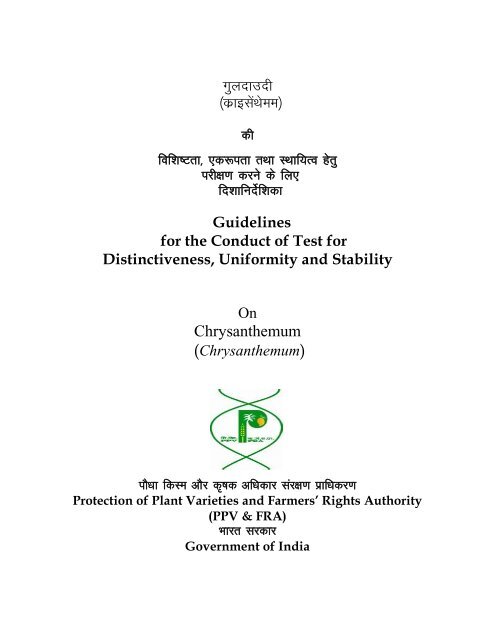
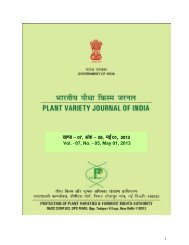
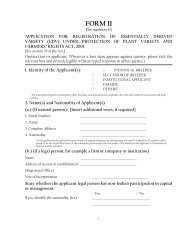
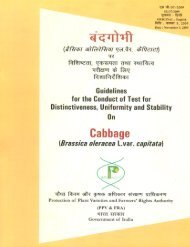
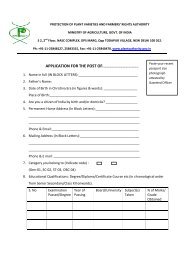
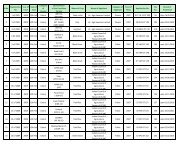
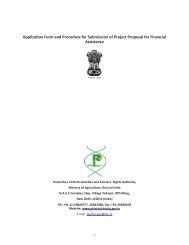
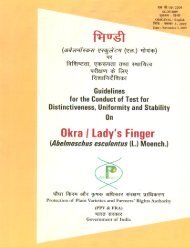
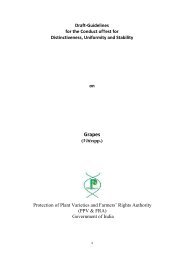
![vad & 12] fnlacj 01, 2010 - Protection of Plant Varieties & Farmers](https://img.yumpu.com/43179759/1/190x245/vad-12-fnlacj-01-2010-protection-of-plant-varieties-farmers.jpg?quality=85)
